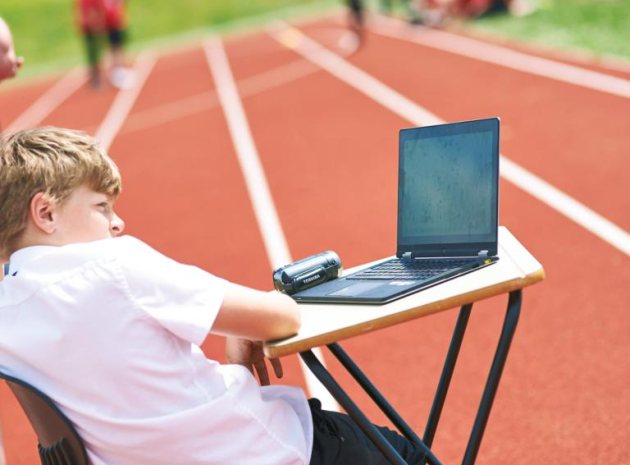Today’s school children have no experience of what the world was like before smartphones, the internet and social media. In its report ‘Class of 2035’, Global trends consultancy the Future Foundation claims that by 2020, there will be 40.9 billion connected devices in conversation. The study, which was carried out for school sport charity the Youth Sport Trust, also found that young people spend on average thirty to forty minutes a day active - but more than three hours using technology.
The report cites a 2014 survey, which identified that 46% of 7-15 year olds owned smartphones, rising to 75% of 12-15 year olds. The same survey showed that 51% of 7-15 year olds owned tablets, 74% had access to games consoles and 51% hand held consoles. Seventy percent of 7-11 year olds surveyed said they used YouTube. So did 89% of 12-15 year olds. Seventy two percent used Facebook.
In the past, technology has been seen as the enemy of physical activity. Why get all hot and sweaty - or worse still play sport in the rain and mud - when you can sit on the sofa and play FIFA 15 on the PlayStation? However, The Future Foundation researchers spoke to a range of education and sports development experts, who told them that wearable technology actually has a great deal of potential to enhance physical activity. The researchers further argue that ignoring its capacity to empower young people, could, in the future, lead to PE and school sport becoming irrelevant to technology mad youngsters, whose physical and mental health would suffer as a result.
Free range
Today’s young people aren’t just digital natives – technophiles, unresponsive to non-technological forms of communication. Neither is it the technology itself that youngsters crave, but more the freedom it offers them to interact with friends, unsupervised, or unrestricted; freedom that has been curbed in the outside world, as modern day culture becomes more fearful and risk averse. Within this culture, the report states, children aren’t just the objects of fear and concern, but the cause of it. There are paedos and asbos on every street corner, even when there’s not; that’s what fear does to public perception.
The report suggests that schools should integrate both technology and physical activity into the everyday lives of pupils. The question is, how best to do it?
Dr Ashley Casey, lecturer in pedagogy at Loughborough University, says that it’s not the technology itself that’s important but how teachers and young people use it. “Gorillas can take photos with iPhones; but it doesn’t mean they know what they’re doing or why,” he says. ‘Often, we come at technology from the wrong direction. My favourite app would always be something boring, like a PDF reader, because it helps me do my job as an academic.” “You don’t go to the shop to buy a drill, because you need a drill,” Casey adds. “You buy a drill because you need a hole and shops don’t sell holes. Depending on how you use it, technology can be very important way of filling gaps in teaching practice.” He suggests that teachers identify the holes in their teaching practice, then decide on the best way of filling them. This is where technology can help. “Technology can do things we can’t do,” he explains. “An iPhone can record a photo finish at a sports day race, accurately, and enable participants to determine, without doubt, who came where in the race. With time delay video on an iPad, a teacher can record kids doing an activity, play it back and provide immediate visual feedback.”
Winning ways
Casey adds that this sort of thing accelerates the learning process. Without the technology, teacher and pupils rely on memory and interpretation; both are subjective, neither reliable. The teacher could spend more time explaining what she has seen, than it took for the young person to actually do the activity. And there’s no guarantee at the end of it that the teacher would persuade the young person that she’d seen things accurately, let alone interpreted what had happened, fairly. Show them the footage, however, and even the most egotistic or stubborn person can’t argue.
And there’s so much technology out there. Gamified sport such as Run An Empire combines a video game-style smartphone app with running challenges. A tennis racquet created by Babolat uses data collected by electronics in the handle to measure metrics about technique and relay the information to a smartphone app. Ashley Casey adds that technology could also be used to enable teachers and parents to effectively monitor and analyse the activity and fitness levels of children and young people.
Teachers don’t need to be technology experts to do this sort of thing, just creative users of simple innovations. Used well, technology enables and facilitates, as Ashley Casey suggests, “Like a good football referee, who remains in the background, almost unnoticed, while the players go about their business to the best of their abilities”.
Action stations
PROFESSIONAL SPORTS TEAMS AND PLAYERS ALREADY USE TECHNOLOGY TO GET, AND KEEP, AN EDGE OVER THEIR OPPONENTS:
- International rugby coaches track players’ movements in training, using GPS sensors placed in their shirts. They can tell how hard a player is training and whether they’re following tactical plans.
- International cricket teams use programmable bowling machines that give batters realistic practice. The machines can replicate the style of bowling used by opposition bowlers.
- Borussia Dortmund Football Club in Germany has a footballnaut training room to improve players’ passing skills. Balls shoot out from four different parts of the room and the receiving player controls and passes to one of the many surrounding targets.
- The Women’s Tennis Association allows coaches to use performance management software on court. Four high-definition cameras set up on a tennis court provide coaches with real time tactical management support. The system tracks the height of the ball over the net, serve speed, form and the depth of balls on the court. It also has a workout function, which tracks the amount of calories burned and the distance a player has covered.
- McLaren Formula One Team, the San Francisco 49ers and the National Hockey League are just a few of the big time sports clubs using software to send send real time information to fans at matches and events, and to homes all over the world.









